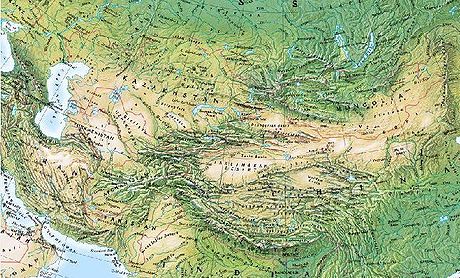
Roof of the World
Encyclopedia

The term is also used for parts of this region, for
- the PamirsPamir MountainsThe Pamir Mountains are a mountain range in Central Asia formed by the junction or knot of the Himalayas, Tian Shan, Karakoram, Kunlun, and Hindu Kush ranges. They are among the world’s highest mountains and since Victorian times they have been known as the "Roof of the World" a probable...
, - TibetTibetan PlateauThe Tibetan Plateau , also known as the Qinghai–Tibetan Plateau is a vast, elevated plateau in Central Asia covering most of the Tibet Autonomous Region and Qinghai, in addition to smaller portions of western Sichuan, southwestern Gansu, and northern Yunnan in Western China and Ladakh in...
- the HimalayasHimalayasThe Himalaya Range or Himalaya Mountains Sanskrit: Devanagari: हिमालय, literally "abode of snow"), usually called the Himalayas or Himalaya for short, is a mountain range in Asia, separating the Indian subcontinent from the Tibetan Plateau...
- Mount EverestMount EverestMount Everest is the world's highest mountain, with a peak at above sea level. It is located in the Mahalangur section of the Himalayas. The international boundary runs across the precise summit point...
The name was first applied to the Pamirs
Pamir Mountains
The Pamir Mountains are a mountain range in Central Asia formed by the junction or knot of the Himalayas, Tian Shan, Karakoram, Kunlun, and Hindu Kush ranges. They are among the world’s highest mountains and since Victorian times they have been known as the "Roof of the World" a probable...
.
The British explorer John Wood
John Wood (explorer)
John Wood was a Scottish naval officer, surveyor, cartographer and explorer, principally remembered for his exploration of central Asia....
, writing in 1838, described Bam-i-Duniah (Roof of the World) as a "native expression" (presumably Wakhi
Wakhi language
Wakhi is an Indo-European language in the branch of Eastern Iranian language family and is intimately related to other Southeastern Iranian languages in the Pamir languages group.-Classification and Distribution:...
), and it was generally used for the Pamirs in Victorian times
Victorian era
The Victorian era of British history was the period of Queen Victoria's reign from 20 June 1837 until her death on 22 January 1901. It was a long period of peace, prosperity, refined sensibilities and national self-confidence...
: In 1876 another British traveller, Sir Thomas Edward Gordon
Thomas Edward Gordon
Sir Thomas Edward Gordon was a Scottish soldier, diplomat, and traveler. A British Army officer, he fought in India, served as a diplomat in Tehran, and travelled across the Pamirs...
, employed it as the title of a bookand wrote in Chapter IX:
- "We were now about to cross the famous 'Bam-i-dunya','The Roof of the World' under which name the elevated region of the hitherto comparatively unknown Pamir tracts had long appeared in our maps.[...] Wood, in 1838, was the first European traveller of modem times to visit the Great Pamir,".
Older encyclopedias also used "Roof of the World" to describe the Pamirs:
- Encyclopaedia Britannica, 11th ed. (1911): "PAMIRS, a mountainous region of central Asia...the Bam-i-dunya ('The Roof of the World')".
- The Columbia Encyclopedia, 1942 edition: "the Pamirs (Persian = roof of the world)".
- Hachette, 1890: "Le Toit du monde (Pamir)", FrenchFrench languageFrench is a Romance language spoken as a first language in France, the Romandy region in Switzerland, Wallonia and Brussels in Belgium, Monaco, the regions of Quebec and Acadia in Canada, and by various communities elsewhere. Second-language speakers of French are distributed throughout many parts...
for "Roof of the World (Pamir)". - Der Große BrockhausBrockhaus EnzyklopädieThe Brockhaus Enzyklopädie is a German-language encyclopedia published by Brockhaus.The first edition originated in the Conversations-Lexikon mit vorzüglicher Rücksicht auf die gegenwärtigen Zeiten by Renatus Gotthelf Löbel and Christian Wilhelm Franke, published in Leipzig 1796-1808...
, Leipzig 1928-1935: "Dach der Welt, Bezeichnung für das Hochland von Pamir", i.e., "roof of the world, term describing the Pamir highlands", and (in translation): "Pamir highlands, nodal point of the mountain systems of Tien-Shan, Kun-lunKunlun MountainsThe Kunlun Mountains are one of the longest mountain chains in Asia, extending more than 3,000 km. In the broadest sense, it forms the northern edge of the Tibetan Plateau south of the Tarim Basin and the Gansu Corridor and continues east south of the Wei River to end at the North China Plain.The...
, KarakoramKarakoramThe Karakoram, or Karakorum , is a large mountain range spanning the borders between Pakistan, India and China, located in the regions of Gilgit-Baltistan , Ladakh , and Xinjiang region,...
, the HimalayasHimalayasThe Himalaya Range or Himalaya Mountains Sanskrit: Devanagari: हिमालय, literally "abode of snow"), usually called the Himalayas or Himalaya for short, is a mountain range in Asia, separating the Indian subcontinent from the Tibetan Plateau...
and Hindukush, and therefore called the roof of the world."
With the awakening of public interest in Tibet, the Pamirs, "since 1875 ... probably the best explored region in High Asia", went out of the limelight and the description "Roof of the World" has been increasingly applied to Tibet and the Tibetan plateau
Tibetan Plateau
The Tibetan Plateau , also known as the Qinghai–Tibetan Plateau is a vast, elevated plateau in Central Asia covering most of the Tibet Autonomous Region and Qinghai, in addition to smaller portions of western Sichuan, southwestern Gansu, and northern Yunnan in Western China and Ladakh in...
, and occasionally, esp. in French ("Toît du monde"), even to Mt. Everest, but the traditional use is still alive.


